Proprietary Technologies

We identify the optimal products for each site from our range of proprietary technologies, and freely combine them as required to achieve sensing performance that meets various usages and needs. We also accumulate and incorporate our technical know-how in various hardware designs, such as communications technologies and optical designs needed for miniaturizing products.
Passive infrared (PIR)
Principle
All humans and other objects emit far-infrared rays (i.e., heat), and measuring the change in heat levels emitted from these objects approaching a sensor enables detecting the object or a human.
Double Conductive Shielding
Blocking infrared rays emitted from light such as sunlight and automobile headlights enables reliably capturing only the temperature changes of the target objects.
Quad-zone Logic
This optical system technology was uniquely developed to prevent incorrect operation caused by pets or the like by differentiating between small animals and humans. Our innovations in detection area design and processing circuitry make this possible.
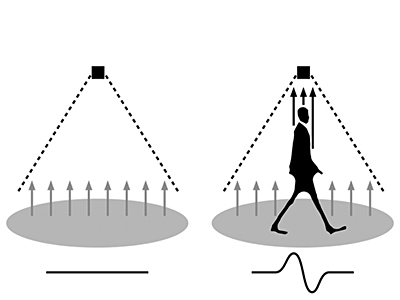
Active infrared (AIR)
Principle
An object is detected by measuring the amount of change, due to light reflection or shielding, in near-infrared rays emitted to the target.
Fast response and clear detection range are characteristics of active infrared.
Noise Reduction Technology
Unique software processing provides support for measures against a wide range of factors that cause false detection, such as natural environmental changes due to rainfall, snowfall, or temperature, and intrusion by a pet or other small animal.
The two conflicting abilities of high sensitivity and reducing false alarms are both achieved by advanced software processing. Also, continuous detection is possible not only for moving objects, but for stationary objects in the detection area as well.
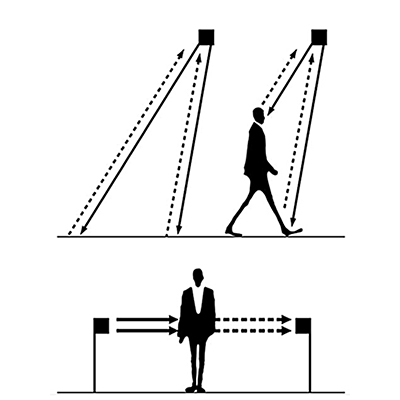
Microwave
Principle
Microwaves are transmitted from an antenna, and a moving object is detected by measuring the change in frequency of the reflected waves. This technology uses the principles of the Doppler effect. Some sensors can also calculate the distance to the object.
Combination with AIR
Safe and fast detection can be achieved by combining microwave technology, which enables setting a wide detection range, and AIR technology, which detects a stationary object in an exact location. Also, some microwave models can determine the direction of an intruding object by taking advantage of the characteristics of microwave technology.
Combination with PIR :Microwave Area Shaping Technology
Through the use of PIR, which performs sensitive detection of human movement, and through the use of microwaves, which are resistant to environments with severe temperature fluctuations, high-reliability detection can be performed with a reduction in missed alarms and incorrect operation due to such factors as movement of small animals or swaying curtains.
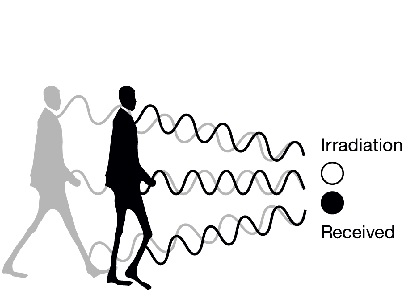
Laser scanning
Principle
Laser sensors can accurately calculate the distance from the sensor to an object by measuring and converting the time it takes laser light emitted from the emitter element to reflect off an object and return (i.e., time of flight). Emitting laser light while rotating the emitter element forms a planar detection area.
Unique algorithms are used to detect only humans and vehicles from the three parameters of an object's size, movement distance, and movement speed. This results in reliably excluding factors that cause false detection due to operating environment conditions such as small animals, swaying vegetation, rain, fog, and snow.。
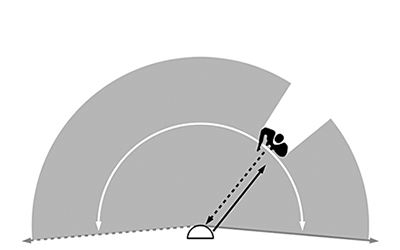
Optical fiber sensor
Principle
Laser light is emitted into an optical fiber cable, and phase shift in the laser light passing through the cable, which is caused by factors such as cable vibration, pressure change, and bending, is detected by the light-receiving section.
The characteristics of this technology enable long-range surveillance that is not subject to electrical or magnetic interference.
Using non-detection fiber cables enables installation at a location 20 km away from the security area. Also, having established technology that detects high frequencies by using a fiber enables a wide variety of applications.
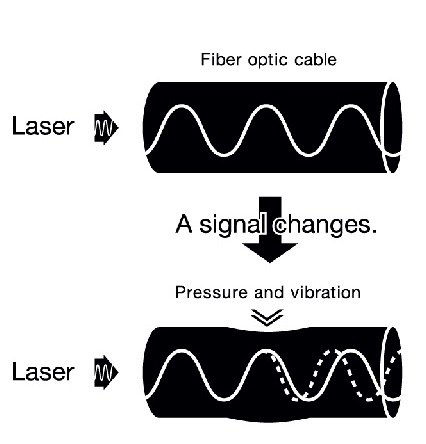
Acceleration
Principle
By detecting changes in the speed of the sensors and processing the measured values into signals, we can obtain a range of information on tilt and movement, vibration and impact.
Noise Canceling Technology
These technologies can identify and record only the necessary usage scenes while eliminating unnecessary recordings that are unrelated to driving behavior (sudden braking and abrupt steering), such as the impact from driving on a very uneven road surface and over crossing junctures.
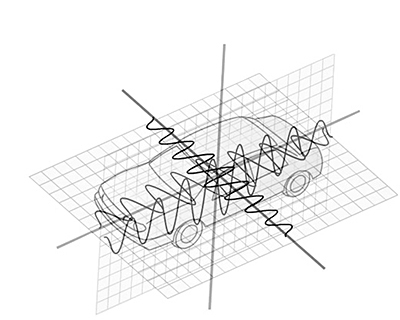
Water Quality Measurement
Principle
We measure water quality, including particle turbidity and color, by combining light measurement formulas developed using Optex expertise and light sources for measuring various wavelengths, according to the features and properties of the objects for measurement.
Minimizing the Effects of LED Light Source Depletion
We use reference light technologies that enable super long-life LED light sources to receive even more base light, which makes it difficult for them to be affected by even the slightest depletion.
Pulse Signal Control that Mitigates the Effects of Ambient Light
We can determine the level of disturbance by turning the light source to ON during pulse transmission and to OFF during no transmission. The effect of ambient light is eliminated by processing only the difference between ON/OFF. This enables stable measurement both indoors and outdoors.
Achieving Stable Measurement in Harsh Environments
We use scratch-resistant sapphire glass on the lenses of our measuring instruments, and our original dirt-resistant wiper control, to reliably and continually monitor water quality. These features eliminate the problems of having to regularly remove dirt from the lens surface, and of it being scratched by minerals, gravel and other substances in the environment being measured. They also enable easy maintenance of the measuring instruments.
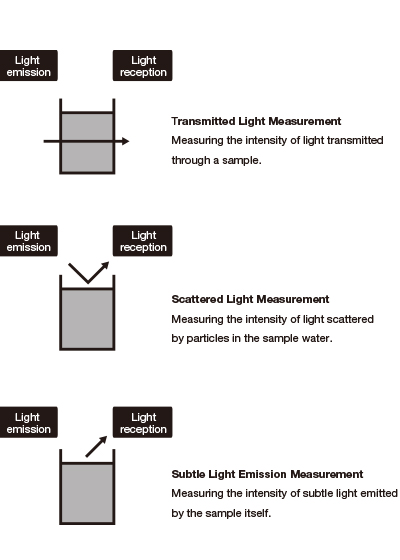
Image recognition (human tracking)
Principle
Image data input using image sensing elements is analyzed, and the detected objects are determined by using unique algorithms.
Image Recognition Technology :Vector focus method
By calculating the vector information from the three-dimensional outer shapes of humans, and then integrating this information, it is possible to accurately detect a human presence. In addition, complex movement of a human and confirmation of shadow presence or absence are automatically determined, and the difference between a shadow and a human can be accurately recognized and counted.

3D range image
Principle
A luminous flux light source of a near-infrared LED is emitted, the emitted light strikes the target object, and the time until it is received by a CMOS image sensor (i.e., time of flight) is converted to distance data for each approximately 20,000 pixels. This enables detecting the distance to an object and capturing three-dimensional shapes.
Optical Technology
Use of area design technology that enables adaptation to a wide variety of applications helps expand the range of implementation and contributes to downsizing.
Noise Reduction Technology
By dramatically improving performance in resistance to environmental factors, typified by sunlight (approx. 10,000 lux), accurate images can be obtained even outdoors without being influenced by the lighting environment or installation conditions.
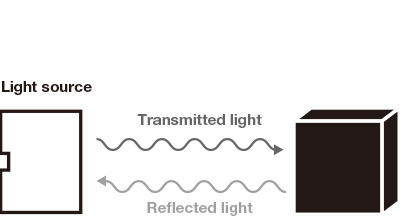
Energy Harvesting
Principle
Converts energy in the environment, such as light, heat (temperature difference), vibrations, and radio waves, into electrical energy. This technology eliminates the need for charging, battery replacement and refueling, and it also doesn’t require wiring for power sources.
Solar Power Generation
Coordinating lighting with sensors can reduce the power used by lights by preventing usage when not needed, and make solar panels and storage cells more compact.
Piezoelectric Generation
Utilizing the energy generated by the force of pushing to control actions such as the open and close signals of doors and the ON/OFF functions of devices and various power sources, will eliminate the need for signal lines and power cables and enable a completely wireless (cable-free) system.
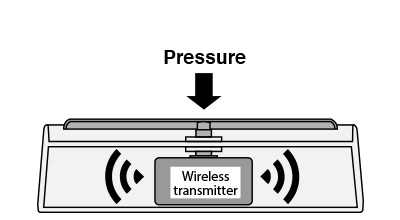
Contact phone number
- Headquarters
- +81-77-579-8000
Contact form
